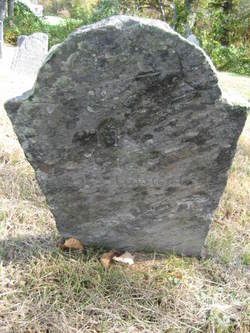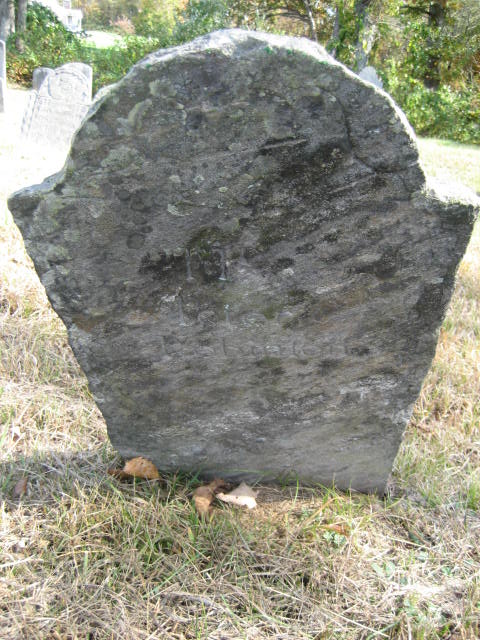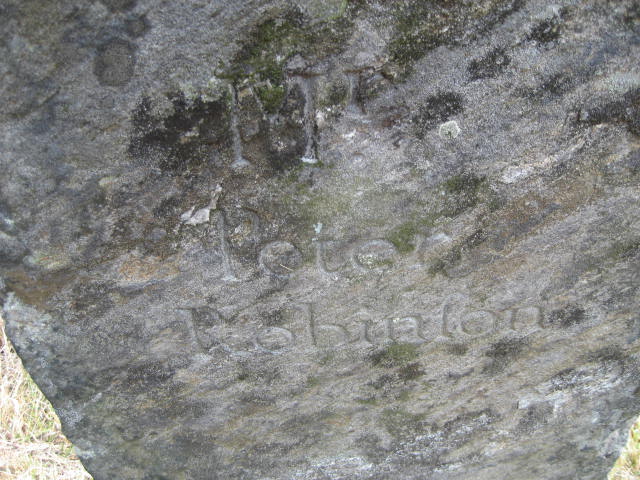Peter was born at Barnstable, Mass. in or before June 1657, s. of Isaac Robinson and his unidentified 2nd wife. Peter's father was the second son and only child of Rev. John Robinson, Jr. and Bridget White to venture to America.
Peter had sixteen children by two wives; three by first wife Mary Manter and thirteen by second wife Experience Lumbert. Thirteen of his children have recorded marriages with eleven leaving known descendants.
Peter died at Windham, Conn. between Feb. 6, 1739/40 (date of his will) and Apr. 15, 1740 (date of probate). The transcribed record of his will and inventory can only be found at the Windham Probate District in Willimantic, Conn. The inventory of his estate's personal property totaling £265-01-01 encompasses 2-1/2 ledger pages. £100 of the inventory concerns two bonds from sons Joseph and Israel.
Peter's first wife Mary Manter died at Tisbury, Mass. before 1696. Second wife Experience Lumbert died 13 years before her husband and is interred with an infant grandson at the Palmertown Cemetery in Scotland, Conn. By virtue of the inscription on Experience's gravestone, her full and correct identity is now known to her descendants-she was the half cousin of her husband's first wife.
The reason for memorializing Peter Robinson's family at Windham is to lay the foundation for finding all of his children's gravestones, if they had one and still exist. The 1925 published Robinson Genealogy contains the purported full date of birth or baptism of 15 of Peter's children and nowhere else do the dates appear in print or in a primary record source. Twelve of the children were born at Martha's Vineyard (Duke's County, Mass.) before even scant vital records are available. In 1941 in a respected genealogy-oriented publication a flawed compilation of the Robinson family was published by a noted New England genealogist. Unfortunately, the author was convinced Peter Robinson's two oldest sons, Israel and Peter, Jr., were twins, notwithstanding they were born almost two years apart and not even in the same month.
The additional argument advanced by the 1941 compilation was that since Peter Robinson, Jr. did not have a daughter named Experience, Mary Manter must have been his mother, notwithstanding that none of Peter junior's four daughters were named Mary. The 1941 author failed to recognize that Peter junior's first four children were individually named for one of their grandparents; it just so happened that the second child named Experience was a boy (who was recorded as being a girl when baptized at the Windham First Church.)
In early New England a family's bible was the primary place in which family vital records were recorded. By virtue of a chain of probate records at Windham, in 1740 Peter Robinson Sr. passed a "great bible" down to his son Peter Robinson, Jr., who passed a "great bible" down to his son Peter 3rd, who passed a great bible down to his daughter Rosamond (Robinson) Wales, who died at Windham in 1849.
In 1864 Rev. John Vinton of Boston published his "Giles Memorial" and praised Alfred Augustus Robinson of Windham, Rosamond (Robinson) Wales' cousin, as the source for Vinton's early extended compilation of the Robinson family at Windham. Vinton extended his compilation to the present-writer's 3rd great Robinson grandfather in Vermont, who Vinton claimed to have personally known - "I honor his memory."
Alfred A. Robinson died at Windham in 1881, yet the author of the 1925 published Robinson Genealogy praised Alfred as the source of many facts concerning the Windham Robinsons that are not now verifiable by primary record sources. Alfred died more than 30 years before the Robinson Genealogy's author ever conceived writing the latter work.
It is often said that it is not possible to put flesh back on ancestral bones. However, gravestones are as close as one can come to ancestral flesh. By virtue of this presentation in Find-A-Grave it is hoped that interested descendants or others will assist in finding all of the extant gravestones of the first generation of the Robinson family at Windham, Conn. This will not only increase descendant knowledge of their ancestors, but finding the grave stones will help to verify the dates of birth printed in the 1925 Robinson Genealogy as likely having come from Peter Robinson senior's "great Bible."
My sincere gratitude is extended to Sara, a Find-A-Grave volunteer, who succeeded in photographing many gravestones of the extended Peter Robinson family at greater Windham, Conn. Other volunteers, who previously photographed one or more gravestones of the extended family, graciously transferred their memorials to the writer.
A final note concerns the now almost universal misrepresentation, to include on Find-A-Grave, of how a person's age at death was recorded on gravestones in North America well into the 1800s. It was by one of the variations of the Latin phrase "Ætatis suæ" -literally "a certain time of one's age"- not the person's chronological age. In Connecticut, as the state's necrologist Hale was concerned with mortality statistics, not how death was recorded in town records and inscribed on gravestones. On the other hand, family genealogists are interested in understanding the nuances of how historical facts were recorded then transcribing them as they were written.
Ætatis suæ reflects that on the day a person is born they are in the first year of their age and on the day a person turns one full year old they are then in the first day of the second year of their age. The variations used for Ætatis suæ in early New England town records, in depositions, and most importantly on gravestones, are Æ, Æt, "Aged" X, "in the XX year of his/her age." Understanding the concept helped the memorialist solve the incomplete identity of several ancestral grandmothers, including Experience (Lumbert) Robinson.
In the presentation of Peter Robinson's descendants each extant gravestone transcription includes a parenthetical explanation of what the inscription says regarding the person's age at death.
n.b. The presentation of Peter Robinson's descendants has grown beyond initial intent. I am reminded of the comment to me several years ago by a well-respected national genealogist that the only claim to fame the Robinson family has is that they descend from the celebrated Rev. John Robinson, pastor at Leiden, Holland of the eventual 1620 Mayflower pilgrims. What is now more relevant is what did John and Bridget (White) Robinson's descendants become in their own right? The commenter would be amazed at who they are.
Peter was born at Barnstable, Mass. in or before June 1657, s. of Isaac Robinson and his unidentified 2nd wife. Peter's father was the second son and only child of Rev. John Robinson, Jr. and Bridget White to venture to America.
Peter had sixteen children by two wives; three by first wife Mary Manter and thirteen by second wife Experience Lumbert. Thirteen of his children have recorded marriages with eleven leaving known descendants.
Peter died at Windham, Conn. between Feb. 6, 1739/40 (date of his will) and Apr. 15, 1740 (date of probate). The transcribed record of his will and inventory can only be found at the Windham Probate District in Willimantic, Conn. The inventory of his estate's personal property totaling £265-01-01 encompasses 2-1/2 ledger pages. £100 of the inventory concerns two bonds from sons Joseph and Israel.
Peter's first wife Mary Manter died at Tisbury, Mass. before 1696. Second wife Experience Lumbert died 13 years before her husband and is interred with an infant grandson at the Palmertown Cemetery in Scotland, Conn. By virtue of the inscription on Experience's gravestone, her full and correct identity is now known to her descendants-she was the half cousin of her husband's first wife.
The reason for memorializing Peter Robinson's family at Windham is to lay the foundation for finding all of his children's gravestones, if they had one and still exist. The 1925 published Robinson Genealogy contains the purported full date of birth or baptism of 15 of Peter's children and nowhere else do the dates appear in print or in a primary record source. Twelve of the children were born at Martha's Vineyard (Duke's County, Mass.) before even scant vital records are available. In 1941 in a respected genealogy-oriented publication a flawed compilation of the Robinson family was published by a noted New England genealogist. Unfortunately, the author was convinced Peter Robinson's two oldest sons, Israel and Peter, Jr., were twins, notwithstanding they were born almost two years apart and not even in the same month.
The additional argument advanced by the 1941 compilation was that since Peter Robinson, Jr. did not have a daughter named Experience, Mary Manter must have been his mother, notwithstanding that none of Peter junior's four daughters were named Mary. The 1941 author failed to recognize that Peter junior's first four children were individually named for one of their grandparents; it just so happened that the second child named Experience was a boy (who was recorded as being a girl when baptized at the Windham First Church.)
In early New England a family's bible was the primary place in which family vital records were recorded. By virtue of a chain of probate records at Windham, in 1740 Peter Robinson Sr. passed a "great bible" down to his son Peter Robinson, Jr., who passed a "great bible" down to his son Peter 3rd, who passed a great bible down to his daughter Rosamond (Robinson) Wales, who died at Windham in 1849.
In 1864 Rev. John Vinton of Boston published his "Giles Memorial" and praised Alfred Augustus Robinson of Windham, Rosamond (Robinson) Wales' cousin, as the source for Vinton's early extended compilation of the Robinson family at Windham. Vinton extended his compilation to the present-writer's 3rd great Robinson grandfather in Vermont, who Vinton claimed to have personally known - "I honor his memory."
Alfred A. Robinson died at Windham in 1881, yet the author of the 1925 published Robinson Genealogy praised Alfred as the source of many facts concerning the Windham Robinsons that are not now verifiable by primary record sources. Alfred died more than 30 years before the Robinson Genealogy's author ever conceived writing the latter work.
It is often said that it is not possible to put flesh back on ancestral bones. However, gravestones are as close as one can come to ancestral flesh. By virtue of this presentation in Find-A-Grave it is hoped that interested descendants or others will assist in finding all of the extant gravestones of the first generation of the Robinson family at Windham, Conn. This will not only increase descendant knowledge of their ancestors, but finding the grave stones will help to verify the dates of birth printed in the 1925 Robinson Genealogy as likely having come from Peter Robinson senior's "great Bible."
My sincere gratitude is extended to Sara, a Find-A-Grave volunteer, who succeeded in photographing many gravestones of the extended Peter Robinson family at greater Windham, Conn. Other volunteers, who previously photographed one or more gravestones of the extended family, graciously transferred their memorials to the writer.
A final note concerns the now almost universal misrepresentation, to include on Find-A-Grave, of how a person's age at death was recorded on gravestones in North America well into the 1800s. It was by one of the variations of the Latin phrase "Ætatis suæ" -literally "a certain time of one's age"- not the person's chronological age. In Connecticut, as the state's necrologist Hale was concerned with mortality statistics, not how death was recorded in town records and inscribed on gravestones. On the other hand, family genealogists are interested in understanding the nuances of how historical facts were recorded then transcribing them as they were written.
Ætatis suæ reflects that on the day a person is born they are in the first year of their age and on the day a person turns one full year old they are then in the first day of the second year of their age. The variations used for Ætatis suæ in early New England town records, in depositions, and most importantly on gravestones, are Æ, Æt, "Aged" X, "in the XX year of his/her age." Understanding the concept helped the memorialist solve the incomplete identity of several ancestral grandmothers, including Experience (Lumbert) Robinson.
In the presentation of Peter Robinson's descendants each extant gravestone transcription includes a parenthetical explanation of what the inscription says regarding the person's age at death.
n.b. The presentation of Peter Robinson's descendants has grown beyond initial intent. I am reminded of the comment to me several years ago by a well-respected national genealogist that the only claim to fame the Robinson family has is that they descend from the celebrated Rev. John Robinson, pastor at Leiden, Holland of the eventual 1620 Mayflower pilgrims. What is now more relevant is what did John and Bridget (White) Robinson's descendants become in their own right? The commenter would be amazed at who they are.
Inscription
Mr.
Peter
Robinfon
Family Members
-
Sarah Robinson Mason
1688–1754
-
Abiah Robinson Andrus
1693–1775
-
![]()
Israel Robinson
1695–1775
-
![]()
Peter Robinson Jr
1696–1785
-
![]()
Ens Thomas Robinson
1698–1783
-
![]()
Abigail Robinson Palmer
1701–1765
-
Simeon Robinson
1703–1792
-
Benjamin Robinson
1704–1772
-
![]()
Joseph Robinson
1706–1789
-
![]()
Isaac Robinson
1708–1796
-
Mary Robinson Johnson
1711–1781
-
Rhoda Robinson
1711 – unknown
-
![]()
Martha Robinson
1713–1753
-
Elizabeth Robinson Smith
1714–1798
-
![]()
Anna Robinson Fuller
1716–1799
Advertisement
Explore more
Sponsored by Ancestry
Advertisement













